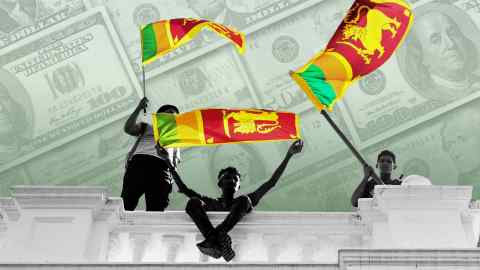
Foreign investors have pulled funds from emerging markets for five straight months in the longest withdrawal streak on record, highlighting how recession fears and rising interest rates are roiling developing economies.
Cross-border outflows by international investors in emerging stocks and domestic bonds reached $10.5 billion this month, according to provisional data compiled by the Institute of International Finance. That brought outflows over the past five months to more than $38 billion, the longest period of net outflows since records began in 2005.
The outflows risk exacerbating a growing financial crisis in developing economies. In the past three months, Sri Lanka has defaulted on its sovereign debt and Bangladesh and Pakistan have approached the IMF for help. A growing number of other issuers in emerging markets are also at risk, investors fear.
Many low- and middle-income developing countries are suffering from depreciating currencies and rising borrowing costs, driven by rate hikes by the US Federal Reserve and fears of a recession in major advanced economies. The United States reported its second consecutive quarterly contraction in output this week.
“EM has had a very, very crazy rollercoaster year,” said Karthik Sankaran, senior strategist at Corpoy.
Investors have also pulled $30 billion so far this year from EM foreign currency bond funds, which invest in bonds issued in the capital markets of advanced economies, according to JPMorgan data.
Foreign-currency bonds in at least 20 frontier and emerging markets trade at yields more than 10 percentage points above comparable U.S. Treasuries, according to JPMorgan data compiled by the Financial Times. Spreads at such high levels are often considered an indicator of severe financial stress and default risk.
It marks a sharp reversal in sentiment from late 2021 and early 2022, when many investors expected emerging economies to rebound strongly from the pandemic. Until April this year, the currencies and other assets of emerging commodity-exporting countries such as Brazil and Colombia performed well as oil and other commodity prices rose after the invasion of Ukraine by Russia.
But fears of global recession and inflation, aggressive US interest rate hikes and a slowdown in Chinese economic growth have seen many investors shrink from EM assets.
Jonathan Fortun Vargas, an economist at the IIF, said cross-border withdrawals had been unusually widespread in emerging markets; in previous episodes, outflows from one region have been partially balanced by inflows to another.
“This time, sentiment is broadly to the downside,” he said.
Analysts also warned that, unlike in previous episodes, there was little immediate prospect of global conditions turning in EM’s favor.
“The Fed’s stance appears to be very different from previous cycles,” said Adam Wolfe, EM economist at Absolute Strategy Research. “He is more willing to risk an American recession and to risk destabilizing financial markets to reduce inflation.”
There are also few signs of economic recovery in China, the world’s largest emerging market, he warned. This limits its ability to drive a recovery in other developing countries that depend on it as an export market and source of financing.
“China’s financial system is under strain from last year’s economic downturn and that has really limited the ability of its banks to continue to refinance all their loans to other emerging markets,” Wolfe said.
A report on Sunday highlighted concerns about the strength of China’s economic recovery. An official manufacturing purchasing managers’ index, which surveys executives on issues such as output and new orders, fell to 49 in July from 50.2 in June.
The reading suggests that activity in the country’s expansive manufacturing sector, an important growth driver for emerging markets in general, has fallen into contraction territory. The decline was due to “weak market demand and production cuts in energy-intensive industries,” according to Goldman Sachs economists.
Meanwhile, Sri Lanka’s default on its foreign debt has many investors wondering who will be the next sovereign borrower to enter restructuring.
Spreads on US Treasuries over foreign bonds issued by Ghana, for example, have more than doubled this year as investors bid on a growing risk of default or restructuring. Very high debt servicing costs are eroding Ghana’s foreign exchange reserves, which fell from $9.7 billion at the end of 2021 to $7.7 billion at the end of June, a rate of $1 billion per quarter .
recommended

If that continues, “over the course of four quarters, all of a sudden reserves will be at levels where the markets are really starting to worry,” said Kevin Daly, Abrdn’s chief investment officer. The government is almost certain to miss its fiscal targets for this year, so reserve flight is expected to continue, he added.
Borrowing costs for large emerging countries such as Brazil, Mexico, India and South Africa have also risen this year, but less so. Many large economies acted early to combat inflation and put in place policies that protect them from external shocks.
The only major EM of concern is Turkey, where government measures to support the lira while refusing to raise interest rates (in effect promising to pay local depositors the cost of the currency’s depreciation to stay with the currency) have a high tax cost.
Such measures can only work as long as Turkey runs a current account surplus, which is rare, Wolfe said. “If it needs external funding, eventually those systems will break down.”
However, other major emerging economies face similar pressures, he added: Reliance on debt financing means that governments eventually have to suppress domestic demand to control debt, risking a recession.
Fortun Vargas said there was little escape from the sale. “What’s surprising is how strongly sentiment has changed,” he said. “Commodity exporters were the darlings of investors just a few weeks ago. Now there are no loved ones.”
Additional reporting by Kate Duguid in London
[ad_2]
Source link


